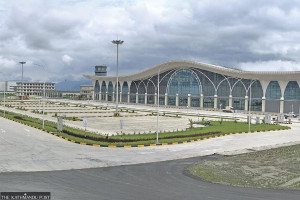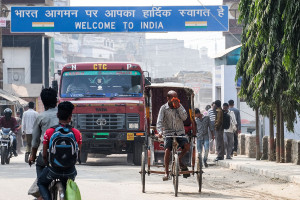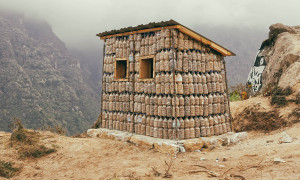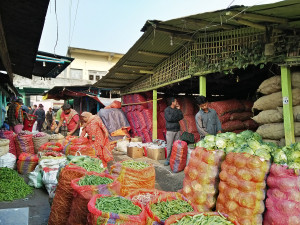Money
Art of transhumance: The intertwined lives of sheep and their Himalayan herders
For shepherds, life on the move also reflects mountain culture. But how long can this way of survival continue?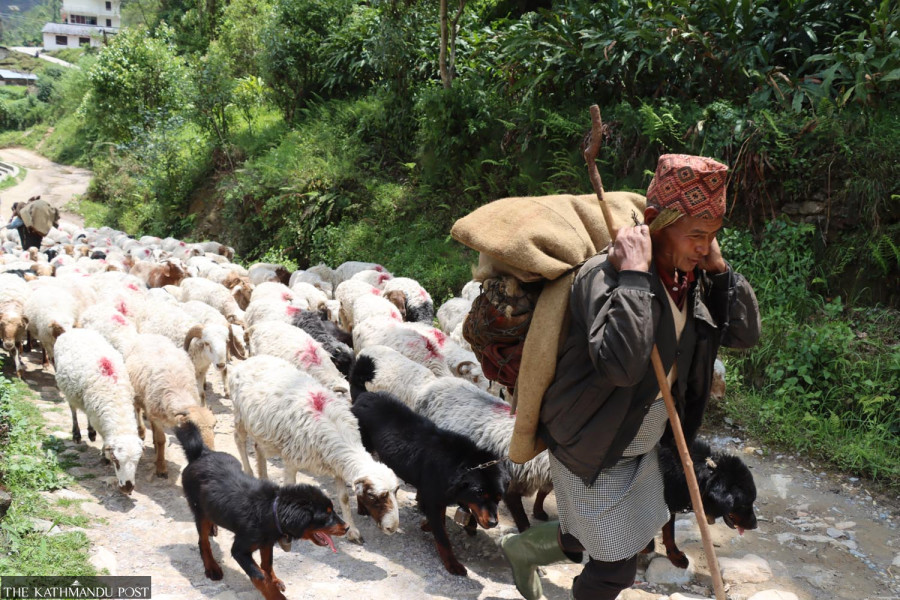
Prakash Baral
Gobinda Adai is 52 years old. For 20 years, he has only gone home during festivals, taking turns with others. The rest of his time is spent with his sheep in the highlands. To escape the cold that numbs his fingers, Adai is now climbing up to Dhorpatan.
Carrying food supplies, cooking utensils, woollen blankets, and traditional woollen coats in a basket, and accompanied by his dogs, he is herding a flock of 200 sheep uphill.
Due to frequent rains since the start of the pre-monsoon season in mid-April, he ascended the hills later than usual.
During the summer, he travels to Dhorpatan and Bukipatan, occasionally descending as far as Nagbeli in Tara Khola and Rum village in Myagdi. When snowfall is heavy, he goes as far as Galkot.
But this year, with no snow, they didn’t need to descend to Galkot. Instead, they stayed in the pastures of Tara Khola and Nagbeli.
He has lived as a nomadic shepherd for years, sustaining himself through transhumance—moving with his sheep from lower to higher altitudes. From this practice alone, he earns nearly Rs1 million a year. Because of this, he has no interest in any other occupation. Sheep farming is his primary livelihood, supporting his household of three sons, one daughter, and his wife.
A resident of Dhorpatan Municipality–6, Adai has lived a nomadic life for 30 years. The first 10 years were spent herding sheep in his uncle's flock, and for the past 20 years, he has owned and managed his flock.
His maternal home is nearby, and he spent much of his childhood there. He often accompanied his uncle Khum Bahadur Bhandari on sheep herding trips, frequently travelling to Dhorpatan and Bukipatan. Inspired by those early experiences, he became a full-time shepherd. This life is his own choice, according to him.
Starting with just 25 sheep, Adai has grown his flock to 200. Among them are six rams older than four years and 30 young ones under three. Most of the animals are sheep. During festivals, he sells rams in particular. So, preparations to raise rams begin at least a year in advance. He has sold rams for up to Rs40,000 each.
On Janai Purnima, a Hindu holy festival celebrated every year on the day of the full moon in July, many seek rams to offer as sacrifice at Dhorbaraha Temple. In other religious rituals, locals around Dhorpatan prefer offering sheep.
Hundreds of farmers around Dhorpatan are involved in sheep herding. Some own just 10–20 sheep, while over 50 farmers have flocks ranging from 100 to 400. They graze in the Dhorpatan valley until mid-April, then move to Bukipatan. Bukipatan, higher than Dhorpatan (3,000 meters), reaches an elevation range of 4,000–4,500 metres. Farmers build temporary sheds there to graze their animals.
All three of Adai's sons are engaged in this profession. His eldest, Prem, his second son, Yuvraj, and his youngest, Devendra, stay with him in the pastures. The youngest, Diamond, and his wife, Bhim Kumari, stay home.
Occasionally, Yuvraj returns home to collect supplies, and Gobinda visits during family events and festivals. His sons joined him after completing basic education, allowing Adai to manage without hiring workers. He rarely leaves the sheep unattended due to the fear of leopards.
Four Tibetan mastiff dogs help guard the flock.
Adai said his sheepfold has never been attacked by leopards at night, thanks to the dogs forming a protective circle. However, leopards have attacked during the day when the dogs are less alert or tethered separately for feeding.
“One of my sheep worth Rs20,000 was eaten by a leopard in April,” he said. “Leopards strike when the dogs aren't around.”
His dogs are so aggressive that they even attack humans if they come too close to the sheep, making it unsafe for strangers to approach.
The dogs also prevent one group of sheep from mixing with another.
“Usually, each flock grazes within its group, so there’s little risk of loss or swapping,” said Adai. “If they stray, the dogs drive them back into their group.”
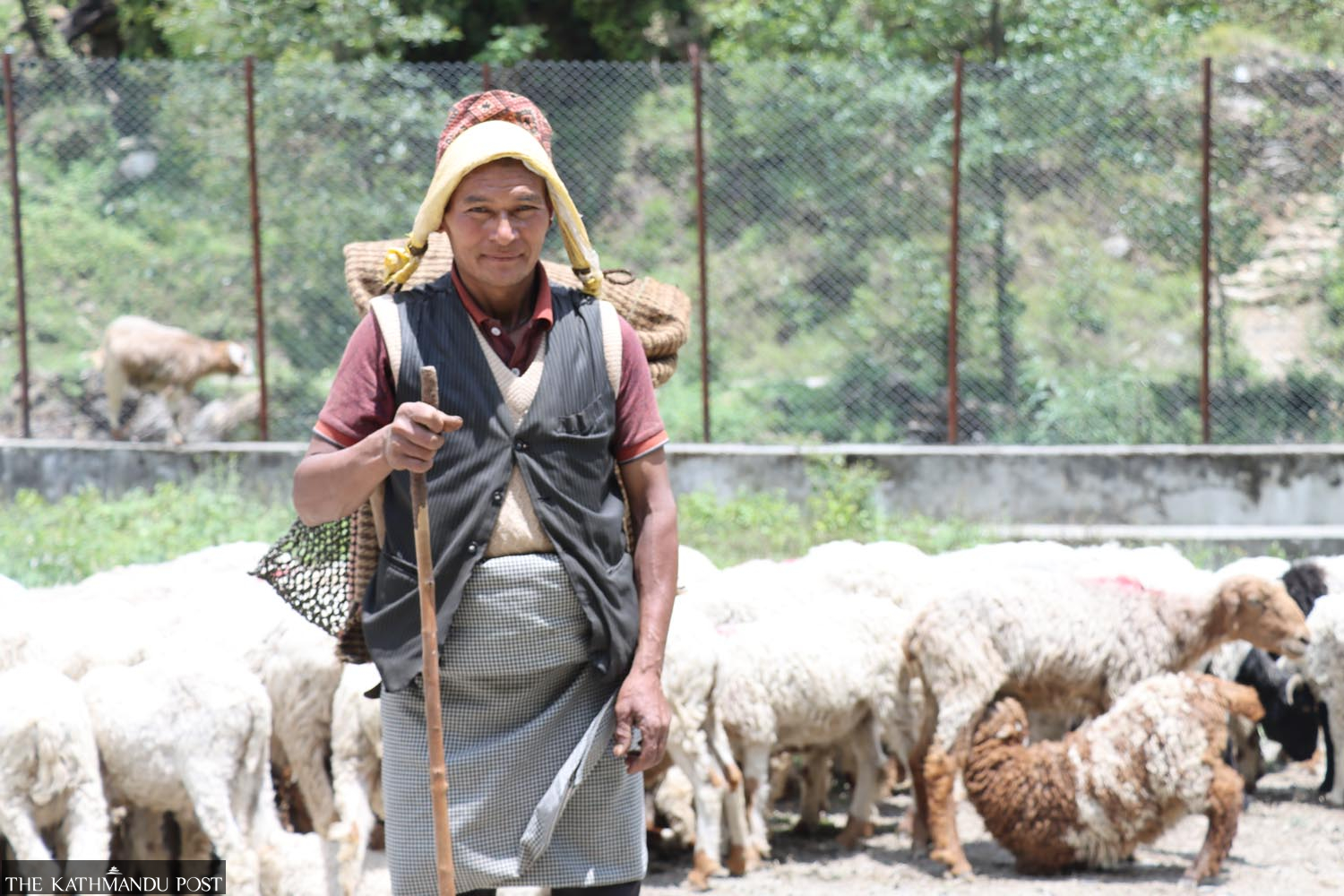
When it’s time to move, he doesn’t need to drive the sheep forcefully. Once the lead dog starts walking, the flock follows. “When we unpack our bags, they start grazing. When we repack and move, they follow,” he said. “Sheep are creatures of habit; if we lead, they’ll follow.”
Salt must be fed to the sheep every month to keep them healthy and well-grown. Without it, they become weak and frail. Salt is scattered over rocks near water sources, and the sheep consume as much as they like before drinking water and returning. The sheep also require occasional medicine and treatment.
In summer, as they descend to lower pastures, they face pasture shortages and heat stress. At such times, their wool is sheared, and they are fed the stalks of millet or wheat. These times are costly for the herd’s upkeep. The wool is spun into yarn, and many households in the area traditionally weave woollen blankets. Some make a living weaving blankets regularly.
Shepherds carry food that lasts 15 days to a month. Their baskets also carry woollen coats, blankets, umbrellas, plastic sheets, and utensils. Wherever night falls, they cook and sleep there. Once they reach Bukipatan, they build shelters and stay with fellow herders.
Rasa Bahadur Gurung, another shepherd, said they take their sheep to pastures as far as Bukipatan and beyond from their village of Lukum in Bhumé Rural Municipality–1 of Rukum. They also graze their flocks in the highlands of Chungri in Rukum. Their seasonal routine includes moving to higher altitudes in summer and descending when the cold increases and their fingers begin to freeze.
Diseases like Peste des petits ruminants (PPR) and goat plague are common in sheep and goats. For this reason, the Veterinary Hospital and Livestock Service Expert Centre conducted vaccination campaigns directly at the sheepfolds in Dhorpatan.
According to livestock technician Keshav Sharma, this year alone, 10,556 sheep and 10,579 goats in Dhorpatan received PPR vaccines. In Taman Khola, 2,527 goats and 2,117 sheep were vaccinated, while in Nisikhola, 11,715 goats and 5,011 sheep were covered.
Dr Rishiram Sapkota, the head of the office, said they also organise regular livestock health camps. “Many farmers raise sheep and goats for income, so we set up health camps,” Sapkota said. “If a disease breaks out and kills the livestock, farmers could lose millions in investment.”
However, no significant diseases, including goat plague, have been observed in Baglung over the past decade. This has made Baglung’s sheep and goats suitable for meeting the government’s meat export targets.
There is also an ongoing campaign to declare Baglung a disease-free district for livestock.
According to Sapkota, there are currently 250,000 livestock in the district, and none are reported to be diseased.
“Once declared disease-free, we plan to establish a mega slaughterhouse in Baglung to process meat for export,” he said. “Being the closest district to Korala in Mustang, near the China border, Baglung is ideal for meat exports.”
To support this, a campaign is underway to expand the population of kids within 30 months of age, aiming to raise them for meat.




 8.12°C Kathmandu
8.12°C Kathmandu.jpg)






